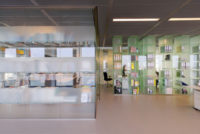Rotterdam, The Netherlands
Doepel Strijkers Architects is revving up to conquer the world, starting with the first-ever sustainable, socially minded, zero-waste tequila factory. Organic tequila, mind you. Doepel Strijkers is the Rotterdam-based firm of architect Duzan Doepel (born in South Africa in 1971) and interior architect Eline Strijkers (born in the Netherlands in 1969). They met while working at MVRDV in the 1990s, and in 2007 joined forces. They now employ nine people. Both have won the AM NAI Public Prize for young talent and a Dutch Design Award. Both also teach, he as a lecturer on sustainable architecture and urbanism at the Research Institute for Sustainable Solutions and she at the Academy of Architecture.
So what is their take on the generic term “sustainability”? “We want to make sustainability into business as usual, but also link it to top design. In order to get mass culture behind you, you have to create an element of desire. It has to look good,” says Doepel. “In light of the resource and energy crises we are facing, sustainability has to be about reconfiguring and repurposing the buildings we already have.”
For the 2012 International Architecture Biennale Rotterdam, Doepel Strijkers is exploring how to double the inhabitants in the city’s center. “In a vibrant city, about 10 percent of the inhabitants live in the center,” says Doepel. “In Rotterdam it’s 5 percent.” The firm is looking at densification strategies such as converting empty offices into housing, building on water, adding floors to existing buildings, and infilling.
An example of the latter is their project Parksite, the conversion of a former ambulance garage on the edge of a secluded park into a single-family home. Another is the 1930s Haka building in the old Rotterdam harbor area, which is being resuscitated as an incubator for start-ups dealing with climate, energy, and water. “It was only logical,” says Strijkers, “that the interior be made of waste materials harvested from demolition sites.”
And then there is the tequila factory in the Mexican state of Jalisco. Everything Doepel Strijkers stands for comes together in this design. A closed production cycle, for example: The fibers from the agave cactus will be turned into clothes and furniture, and waste from the production process will be used to generate energy. “The building has a circular metabolism; that means that all waste streams are put to use. In addition to tequila, honey and furniture are made from the agave fibers. And as part of the energy strategy, the organic waste is fermented to make bio-gas,” says Doepel. In addition to the factory, the complex is designed to house a hacienda with a school, a library, offices, a museum, a chapel, studios for artists in residence, and housing.
The design is bioclimatic: The movement of the sun determines the massing, orientation, and the shape and size of the windows. “This is an aesthetic that is derived from the climate, the location, and the local vernacular,” Doepel says. As if to prove their dedication to this philosophy, they are (small) project shareholders. No wonder Doepel and Strijkers are called “design activists.”
Doepel Strijkers Architects
LOCATION: Rotterdam, The Netherlands
FOUNDED: 2007
DESIGN STAFF: 10
PRINCIPALS: Duzan Doepel, Eline Strijkers
EDUCATION: Doepel – Rotterdam Academy of Architecture, M. Arch., 1999; University of the Witwatersrand, B. Arch, 1995. Strijkers – Willem de Kooning Academy, B.A.A, 1995; Ichthus Hogeschool, Design and Communication, B.Comm, 1992
WORK HISTORY: Doepel – MVRDV, 1996–2002. Strijkers – MVRDV, 1994–99
KEY COMPLETED PROJECTS: Korea National Housing Corporation Office, South Korea, 2010; HAKA Recycle Office, Rotterdam, 2011
KEY CURRENT PROJECTS: NAI Climate Square, Rotterdam, 2012
WEB SITE: www.dsarotterdam.com


















Post a comment to this article
Report Abusive Comment